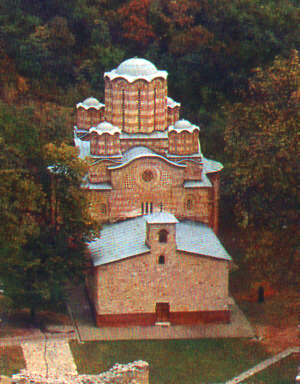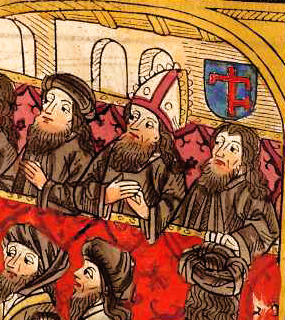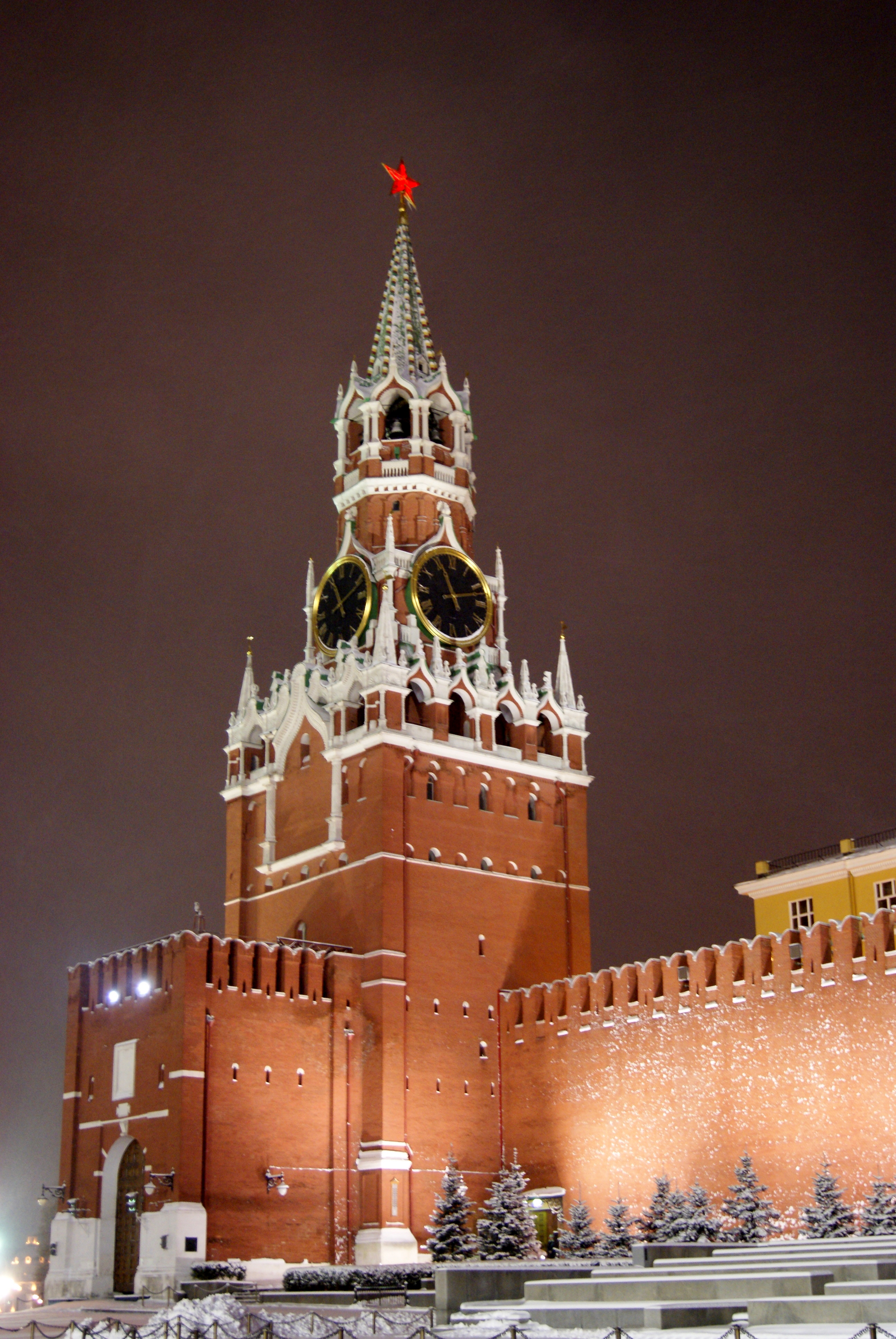|
Grigorije Of Gornjak
Grigorije of Gornjak ( sr, Григорије Горњачки, Григорије из Горњака; 1375–1379), also known as Grigorije the Younger () and Grigorije the Silent (), was Serbian Orthodox monk who was canonized as saint. He studied at Mount Sinai with his teachers were Gregory of Sinai and Romylos of Vidin. Together with a group of Serbian, Bulgarian and Greek monks, Grigorije returned to Moravian Serbia between 1375 and 1379. They established a strong hesychastic colony led by Grigorije. Their patron was Prince Lazar who built the Gornjak monastery for their colony. He endowed it to Grigorije and his fellow monks by written chapter, confirmed by the Serbian patriarch on 17 May 1379. Grigorije spent the rest of his life at the monastery. Early life Grigorije, a Serb, moved from Constantinople to Paroria, a famous monastic colony in Thrace. There he met Roman and his friend Ilarion, former students of Gregory of Sinai. Romil moved from other monks in a separate ... [...More Info...] [...Related Items...] OR: [Wikipedia] [Google] [Baidu] |
Hesychasm
Hesychasm (; Greek: Ησυχασμός) is a contemplative monastic tradition in the Eastern Orthodox Church in which stillness (''hēsychia'') is sought through uninterrupted Jesus prayer. While rooted in early Christian monasticism, it took its definitive form in the 14th century at Mount Athos. Etymology Hesychasm ( el, , Modern ) derives from the word ''hesychia'' (, ), meaning "stillness, rest, quiet, silence" and ''hesychazo'' ( ) "to keep stillness". Origins and development Metropolitan Kallistos Ware, a scholar of Eastern Orthodox theology, distinguishes five distinct usages of the term "hesychasm": # "solitary life", a sense, equivalent to "eremitical life", in which the term is used since the 4th century; # "the practice of inner prayer, aiming at union with God on a level beyond images, concepts and language"; # "the quest for such union through the Jesus Prayer"; # "a particular psychosomatic technique in combination with the Jesus Prayer", use of which technique ... [...More Info...] [...Related Items...] OR: [Wikipedia] [Google] [Baidu] |
Ravanica Monastery
The Ravanica Monastery ( sr, / ) is a Serbian Orthodox monastery on Kučaj mountains near Senje, a village in Ćuprija municipality in Central Serbia. It was built in 1375–1377 as an endowment of prince Lazar of Serbia, who is buried there. The Ravanica church is called the birthplace of the new artistic movement "Morava school" because of architectural and artistic features. It is original blend of the Mount Athos and the cross-in-square five-domed model that became standard in the time of King Milutin. Ravanica was declared Monument of Culture of Exceptional Importance in 1979, and it is protected by Republic of Serbia. History Built between 1375 and 1377, Ravanica is the famous endowment of Prince Lazar, where he was buried after his death in the Kosovo battle. Since then, Ravanica has been a pilgrim's destination and an important center of cultural activities & assemblies for the Serbian people. The monastery was assaulted and damaged by the Ottoman Turks several ti ... [...More Info...] [...Related Items...] OR: [Wikipedia] [Google] [Baidu] |
Gregory Tsamblak
Gregory Tsamblak or Grigorij Camblak ( bg, Григорий Цамблак, sr-Cyr, Григорије Цамблак; c. 1365–1420) was a Bulgarian writer and cleric. He was the pretended Metropolitan of Lithuania between 1413 and 1420. A Bulgarian noble, Tsamblak lived and worked in Bulgaria, but also in Medieval Serbia and Kievan Rus'. His literary works represent a heritage of the national literature of Serbia, particularly the style of Old Serbian ''Vita'' made popular in the monasteries of the 12th century. Life He was born in Tarnovo, the capital of the Second Bulgarian Empire, the son of a rich family. His cousin was Cyprian, Metropolitan of Kiev. Tsamblak was a disciple of the prominent Bulgarian hesychast writer Patriarch Evtimiy of Bulgaria. Bulgaria fell under Ottoman domination following the Bulgarian-Ottoman Wars. Following this, he emigrated first to Constantinople, then became presbyter of the Church of Wallachia and Moldavia. He then went to Serbia where he wa ... [...More Info...] [...Related Items...] OR: [Wikipedia] [Google] [Baidu] |
Cyprian, Metropolitan Of Kiev
Cyprian ( bg, Киприан, russian: Киприан, be, Кіпрыян, uk, Кипріан) (c. 1336 – 16 September 1406) was the Metropolitan of Kiev, Russia and Lithuania (2 December 1375–12 February 1376) and the Metropolitan of Kyiv and All Rus' (12 February 1376–16 September 1406) in the Ecumenical Patriarchate of Constantinople. During both periods, he was opposed by rival hierarchs and by the Grand Prince of Moscow. He was known as a bright opinion writer, editor, translator, and book copyist.Shabuldo, F. Cyprian (КИПРІЯН)'. Encyclopedia of History of Ukraine. 2007 He is commemorated by the Russian Orthodox Church on May 27 and September 16 (by the Old style). Early life Cyprian was a clergyman of Bulgarian origin. He is supposed to have been born in aristocratic family of Tsamblak from the capital Tarnovo. After his upbringing, education, and worldview, he was a hesychast. As a young man Cyprian studied at Kilifarevo, just south of Tarnovo, where ... [...More Info...] [...Related Items...] OR: [Wikipedia] [Google] [Baidu] |
Constantine Of Kostenets
Constantine of Kostenets ( bg, Константин Костенечки, Konstantin Kostenechki; born ca. 1380, died after 1431), also known as Constantine the Philosopher ( sr, Константин Филозоф), was a medieval Bulgarian scholar, writer and chronicler, who spent most of his life in the Serbian Despotate. He is best known for his biography of Serbian despot Stefan Lazarević, which George Ostrogorsky described as "the most important historical work of old Serbian literature",Ostrogorsky, ''History of the Byzantine State'', translated by Joan Hussey, revised edition, (New Brunswick: Rutgers University Press, 1969), p. 471 and for writing the first Serbian philological study, ''Skazanije o pismenah'' (A History on the Letters). He followed the writing style of the Old Serbian ''vita'', first made popular in the Serbian scriptoria of the 12th century. Biography Constantine was born in Bulgaria, probably in Kostenets. In his youth, he attended school in the capital ... [...More Info...] [...Related Items...] OR: [Wikipedia] [Google] [Baidu] |
Gabriel The Hilandarian
Gabriel the Hilandarian ( 1359–d. after 1412) was a Serbian monk- scribe. There is very little information available about Gabriel the Hilandarian, like most modest monks who lived in the 14th and early 15th century. It is known that he translated Olympiodorus the Younger's commentary on the Book of Job from Greek in 1411–12. The manuscript is now held at the State Historical Museum in Moscow. In his younger days, Gabriel resided and worked at the Resava (Manasija) Monastery, built between 1407 and 1418 by Despot Stefan Lazarević. According to Constantine of Kostenets, Resava was built specifically as a centre for the followers of the Hesychasm movement, showing that Stefan held them in great esteem. Stefan endowed Resava generously with icons and books, and established a scriptorium and a translation school within the monastery. Old texts were corrected and copied and many were translated from Hebrew, Greek, Old Armenian, Old Georgian, Coptic, Syriac, and Old Latin. Among ... [...More Info...] [...Related Items...] OR: [Wikipedia] [Google] [Baidu] |
Miroslav Gospel
Miroslav Gospel ( sr, Мирослављево jеванђеље / Miroslavljevo jevanđelje, ) is a 362-page Serbian illuminated manuscript Gospel Book on parchment with very rich decorations. It is one of the oldest surviving documents written in the Serbian recension of Church Slavonic. The gospel is considered a masterpiece of illustration and calligraphy. During Saint Sava's time, a Serbian ''Prophliestologion'' (Cod. 313), a Novgorod Sticherarion (Cod. 301), and Kiev Irmologion (Cod. 308 with Old Church Slavonic musical neumatic notation were also found in the same place as Hilandar Fragments from the 10th and early 11th century (now in Odessa). It is presumed that both Miroslav Gospel and Vukan's Gospel reached Hilandar at the same. Origin and discovery Miroslav's Gospel was commissioned in the 12th century (in the year 1180) by Miroslav, the ruler (''knez'') of Hum and the brother of Stefan Nemanja, the Grand Prince of Serbia. The first to discover and study the manu ... [...More Info...] [...Related Items...] OR: [Wikipedia] [Google] [Baidu] |
Pachomius The Serb
Pachomius the Serb (russian: Пахомий Серб, sr, Пахомије Србин), also known as Pachomius Logothetes, russian: Пахомий Логофет, el, Παχώμιος Λογοθέτης) was a 15th-century Serbian hagiographer who, after taking monastic vows, was schooled on Mount Athos and mastered the ornate style of medieval Serbian literature.G. M. Prokhorov, “Pakhomii Serb,” in D. S. Likhachev, ''Slovar’ knizhnikov i knizhnosti Drevnei Rusi'', vol. 2, Pervaia polovina XIV-XVI v., pt. 2. He is credited by the Russian Early Texts Society for the Serbian version of Barlaam and Josaphat from Old Greek. In the 1450s and 1460s he resided at the Trinity Monastery of St. Sergius north of Moscow. One of his major undertakings was a Russian translation of the New Testament. In about 1470 Archbishop Jonas (Iona) asked him to settle in Novgorod where he prepared a set of the lives of local saints. It has been suggested that ''The Tale of the Princes of Vladimir ... [...More Info...] [...Related Items...] OR: [Wikipedia] [Google] [Baidu] |
Lazar The Hilandarian
Lazar ( sr, Лазар, russian: Лазарь), also known as Lazar the Serb or Lazar the Hilandarian ( fl. 1404), was a Serbian Orthodox monk-scribe and horologist who invented and built the first known mechanical public clock in Russia in 1404. The clock, which also struck the hours, was built at the request of Grand Prince Vasily I of Moscow (r. 1389–1425). Prior to his arrival in Moscow, Lazar had served as a monk in the Serbian Hilandar monastery at Mount Athos. The clock tower was located in the palace behind the Cathedral of the Annunciation. However, the clock and the church in which it was located have not survived. Life A Serb, Lazar was born in the town of Prizren, in the Serbian Empire. He was a monk with the rank of ''crnorizac'' ( sr, црноризац, russian: чернец, ''černec'') serving at the Serbian Orthodox Hilandar monastery, a centre of Serbian religious and secular culture and "the first Serbian university", located on Mount Athos. Lazar likely l ... [...More Info...] [...Related Items...] OR: [Wikipedia] [Google] [Baidu] |
Antonije Bagaš
Anthony Bagaš also known as Arsenije Bagaš ( sr, Антоније Багаш; fl. 1366 – 1385) was a Serbian nobleman from Kastoria who retreated to Mount Athos in between 1356 and 1366, where he later bought and restored the ruined Athonite monastery of Saint Paul (Agiou Pavlou) with the help of Nikola-Gerasim Radonja (the son of ''sebastokrator'' Branko Mladenović) in the 1380s, becoming its abbott - taking the monastic name Arsenios (Arsenije).Rosenqvist, p. 63 The two were successful in receiving donations from both the Byzantines and Serbs, and refurbishing the monastery with revenue from Serbian silver and gold mines, making it one of the major Serbian monasteries. He translated hagiographical works into Serbian. He had a brother, Nikola, who in 1385 donated the monastery of Mesonesiotissa near Edessa, together with villages, churches and other property to the Saint Paul monastery of Arsenije. Some scholars believe that the Bagaš family was originally from Vr ... [...More Info...] [...Related Items...] OR: [Wikipedia] [Google] [Baidu] |
Elder Grigorije
Elder Grigorije ( sr, Старац Григорије; 1310–55) was a Serbian Orthodox clergyman and writer. Grigorije hailed from the Prizren region, and was a nobleman in the Serbian Empire until he took monastic vows and received the monastic title of ''elder'' (''starac''). Together with monk Jakov of Serres he led the building of the Monastery of the Holy Archangels in Prizren, the endowment of Emperor Stefan Dušan (r. 1331–55), and became the first ''hegumen''. Grigorije and monk Teodosije of Hilandar together left Mount Athos for Serbia where they would write the „Žitije svetog Petra Koriškog“, as well as songs and services for the Saint. It is thought that he was one of the protégés of Gregory of Sinai, and there exists indications that he is the so-called "Danilo's pupil" (''Danilov učenik''), i.e. the main author of the great work ''Žitija kraljeva i arhiepiskopa srpskih'', which was started by Archbishop Danilo II (s. 1324–37). See also *Teodosije the ... [...More Info...] [...Related Items...] OR: [Wikipedia] [Google] [Baidu] |
Teodosije The Hilandarian
Teodosije the Hilandarian or Theodosije of Hilandar ( sr, Теодосије Хиландарац/Teodosije Hilandarac; 1246–1328) was a Serbian Orthodox clergyman and one of the most important Serbian writers in the Middle Ages; the Serbian Academy of Sciences and Arts named him one of the 100 most prominent Serbs. Biography He was born in around 1246. He was a monk of Hilandar (hence his epithet), the Serbian monastery of Mount Athos, and a priest of King Stefan Uroš III Dečanski (r. 1322–31). He focused on expanding and strengthening the cult of St. Simeon the Myrrhflowing (Stefan Nemanja) (r. 1166–1196), and Saint Sava, who had created the main focus of the Serb ethnic and cultural identity.Alexander Kazhdan (editor), „The Oxford Dictionary of Byzantium“, Oxford, 1991. In the period between 1292 and 1310 he wrote a ''Common Canon to Christ, St. Simeon Nemanja and St. Sava, The Life of Saint Sava, Encomium to Ss. Simeon and Sava, Common Canon to Ss. Simeon and Sav ... [...More Info...] [...Related Items...] OR: [Wikipedia] [Google] [Baidu] |




